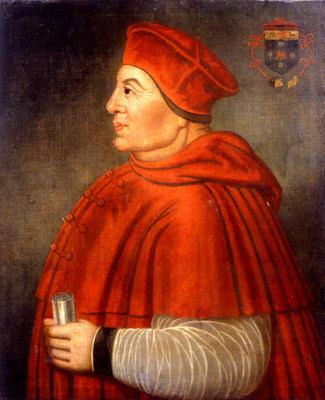
English School
To view all current artworks for sale visit philipmould.com
This painting is an example of the only known oil portrait type of the Cardinal that has a claim to derive from a portrait executed in the cardinal’s lifetime. It depicts him in the full magnificence of his Cardinal’s robes and at the height of his power as Cardinal Legate in England, before the King’s ‘Great Matter’, the need for a divorce from Catherine of Aragon, and the machinations of the Duke of Norfolk and Anne Boleyn’s faction combined to bring about his ruin. It is an impressive icon of the last great churchman who wielded unequalled temporal power in England, one of the last and most successful beneficiaries of the medieval practice of recruiting minsters and statesmen from among the clergy.
Three-quarter-length variants are in the collection of the New Zealand Church Commissioners and at Christ Church, Oxford, the latter of which has been traditionally attributed to Sampson Strong. A smaller example is in the collection of the Bodleian Library. These examples are datable to c.1 600, and though the type is widely disseminated (an example of which was painted among a gallery of historical worthies at the Chateau de Chambord at the beginning of the seventeenth century), the original of c. 1520 remains untraced. A further example in the collection of the National Portrait Gallery, London (NPG 32) was painted in the early seventeenth century for William Sheldon’s gallery of English monarchs and represents a more generalized interpretation of the portrait, in which the details of characterization and costume have been blunted in comparison with the present example. In this portrait, the detailed treatment of such elements as the fastening of Wolsey’s robe, and the inclusion of the warts on upper lip and chin show an impressive fidelity to the lost original.
The Cardinal’s powerful, pugnacious countenance is depicted in profile, an increasingly old-fashioned idiom, by his lifetime, and a curious proof perhaps that despite his extravagant tastes, Wolsey’s own artistic patronage was less progressive than that of the monarch he served. We assume that Wosley’s memorable ugliness in these portraits is an accurate transmission of the likeness in the early Tudor original, since the versions agree on its details. However, a drawing of Wosley by Jacques le Boucq (Bibliothèque d’Arras), admittedly deriving from a drawing taken somewhat earlier in Wolsey’s life c.1515 - 20, shows a smoother faced prelate. Perhaps to an English audience, for whom the tradition of Wolsey’s low beginnings as ‘an Ipswich butcher’s son’ was an integral aspect of his character, this proletarian ugliness was an essential rather than an incidental aspect of Wosley’s appearance. Thus the warts remain and even become more obtrusive as the portrait is reproduced — an anonymous eighteenth century engraving doubles the number of warts on the Cardinal’s chin - just as later repetitions of Richard III’s portrait often increase the suggestion of the hunchback that contemporaries felt to be the outward manifestation of his presumedly evil character. -
Wosely is shown in his robes as a Cardinal, and holding a document, which may well represent the Papal Bull appointing him Cardinal or Legate a latere. The coat of arms in the top right of the portrait is topped by Wolsey’s Cardinal’s hat. Certain of the charges on the arms are thought to allude to personalities relevant to Wolsey: the rose in chief plainly refers to Wolsey’s Tudor patronage, the lion, it is suggested, to Pope Leo X Medici, who made him cardinal, and the choughs to the arms of St Thomas a Becket. The blue leopards’ heads may be borrowed from the de la Pole Earls of Suffolk, in which county Wolsey was born.
It might seem unusual that Wolsey’s image should be reproduced after his fall. To orthodox opinion under Edward and Elizabeth he was a priest of an illegal religion, and as a Cardinal Legate he was answerable not only to the English Crown but also to a foreign and -necessarily- hostile power. To the Marians, conversely, he was party to the divorce and ignominy of the Queen’s mother. Despite these impediments, men throughout the sixteenth and seventeenth centuries recognised Wolsey’s outstanding talents in statecraft and diplomacy, and remembered him as a remarkable minister. His biography remained compelling, and George Cavendish’s L4fe of Wolsej, written contemporary with its subject, was reissued in editions such Dr Stephen Batman’s illustrated transcription of 1578. This present portrait was no doubt commissioned and appreciated in the same spirit. As one of a number of portraits of prominent men it would have been hung placed, perhaps in a nobleman’s library, as an inspiration and as a visual record of one of the great moments of English history and of the Tudor dynasty.
Thomas Wolsey’s tireless industry and inspired statecraft alone should secure him the renown of one of this country’s greatest public servants. It is his misfortune, however, to have combined this talent with an undeniable love of magnificence for its own sake. The splendour of his office does indeed appear remarkable to modern readers -as indeed his much-repeated use of ‘I and the King’ did to contemporaries- but it must be interpreted in more generous light. When, at the Field of the Cloth of Gold, it was stated that those who attended a Mass celebrated by the newly-appointed Legate a latere in his Pontificals would receive a full remission of sins Wolsey was proposing nothing in excess of Catholic dogma or his legatine authority.
Be the first to hear about our available artworks
* denotes required fields
We will process the personal data you have supplied in accordance with our privacy policy (available on request). You can unsubscribe or change your preferences at any time by clicking the link in our emails.